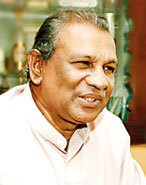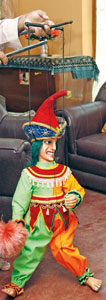A little further than the instructed one kilometre down the by-road, we stop to ask for directions. With no address and only a given name to go with, success seems unlikely. But we are mistaken, for not only down Elpitiya Road but through the Ambalangoda district, the puppet master Premin is more than just well known. The legacy his father Ganwari Jemis and his father’s father Ganwari Podi Sirina left for him, which he struggles now to guard, is that well treasured.
 |
| Premin: Trying hard
to carry on a legacy |
Kalabhushana Ganwari Premin is passionate about his puppets. The decades he has dedicated to learning and adapting traditional naadagam scripts, musical forms and dances have taken him to many stages and carnival sites around the world. Not only is he one of the country’s leading puppeteers, he is also an ardent historian and promoter of the art.
His smiling eyes light up animatedly as he pulls out volume upon volume of neat scrapbooks on which posters, paper-cuttings, photographs, letters and even envelopes, connected to Sri Lankan puppetry and dating from the 1940s are meticulously arranged.
Premin’s grandfather, Ganwari Podi Sirina Guru is popularly considered the father of traditional puppetry. He is credited with introducing not only screens to the Sri Lankan puppet stage, but also the popular Nango Hami and Sellan Lama characters who sometimes perform introductory acts to the main play. Podi Sirina is recorded to have presented the controversial (and immensely popular) play ‘Ehelepola’, based on the massacre of the Kandyan family of that name, before the Duke of Edinburgh in 1870 at the Bagatale Walawwa. The Duke and his retinue were so thrilled with the performance that, according to Premin, they awarded Podi Sirina a gold medal as well as five hundred rupees – a fortune at the time!
Such royal encouragement helped Podi Sirina and his contemporaries work towards improvement and propagation of the art across Sri Lanka, but unfortunately it was not enough to prevent the complete cast of 47 puppets from the ‘Ehelapola’ play from being sold in 1910 and shipped to West Germany. Although puppets were not unfamiliar to a European population, the stature of the life-size creations are said to have created a stir, miniatures being the norm.
These figures, as all other traditional Sri Lankan puppets, are made of the wood of the goda kaduru tree. It is soft and pliable, as well as light, perfect for the job. The puppet is fashioned as a number of parts measured to exact proportions, the calculation of which is known as path bindeema. Once the separate pieces have been carved and detailed, the painting begins.
 |
| Pix by Indika Handuwala |
Traditionally, either valicchi (a concoction made of various powdered natural ingredients) or dorana thel were used to colour the puppets. The centre of the massive dorana tree, which grows in our rainforests, is carved out and the cavity set fire to. The sap then drips into coconut shells arranged at the bottom of the cavity, and is later treated before being used as paint. Different colours and patterns are used to define characteristics of the figure, pink skin always indicating femininity while bold patterns signal either divine or legendary characters.
The pieces of the puppet are now jointed together, and costuming begun. “They’re just like actors,” smiles Premin as he opens box after box of polythene-wrapped clothes, “each puppet has many outfits.”
The puppet stage is made of two sections, the front for the play proper and the elevated back for the hidden artists. Puppeteers bend over the separating screen as they work, leaning their weight on a smooth pole to prevent spine injury as the figures, despite being hollow, are rather large and heavy. Premin treasures a nearly 200 year-old head-part of one mammoth piece, the face of an aristocrat fitted with the typical moustache made of human hairs, which he believes belonged to a nearly six-foot figure.
“Meka raekaganna, meka kaewa” (“to protect this, they ate that”) Premin sighs, pointing first to his belly and then the damaged face-figure, as we speak of art in contemporary Sri Lanka. If there is one thing he regrets, it is how traditional art which has intellectual as well as entertainment value is not appreciated as well as more modern forms, and is simply exploited for financial gain. “We have a tradition of puppetry that has exceeded that of many other countries, but there is hardly any reception in our own land,” he shares regretfully. And this, he believes, is causing the art itself to decline in standards.
Nostalgically he speaks of a time when as a young boy he would tour the country with his father, performing at carnival after carnival for months on end, during school vacations. “I have seen all the masters,” he declares proudly, reminiscing the good times of his youth, “but they were masters mostly because they had an audience that enjoyed and critically understood their work, so they were continually challenged.”
Premin yearns to build a similar audience in contemporary society and thereby promote the growth of the number of practitioners, which he believes is currently less than two hundred, because he is thoroughly convinced of the value of this art. “I can’t help but imagine the possibilities,” he says, speaking animatedly of television, advertising, media and education combined with puppetry. Dreamily he remembers how “once in Kurunegala, my father had to stop in the middle of the ‘Ehelepola’ because the audience was moved to tears and wailing. That is the kind of impact we can create.”
Next Friday, October 21, Premin will bring his vidhanes and puja dancers, his stilt-walkers and fire-eaters, his satirists and his historical characters to present Colombo with a performance at the Navarangahala at Royal College, starting at 6.30 p.m. He hopes it will help improve public awareness of, and interest in the art. Premin’s son, fourth-generation artist Indika, too will join him and his company on this trip.
Indika’s four-year-old daughter hurries her grandfather as she expertly helps him fit a puppet twice her size into its cloth bag. She is already on her way to taking up the family legacy. Giggling shyly, she follows the 65- year-old artist from his house, down the narrow gravel path that leads to Pokuna Paara off Elpitiya Road.
He gently tells her to go back home, as he is heading to Colombo to finalize plans for the programme, that is immensely important to him. “Naethiwunanam mata vitharai, raekunanam mulu ratatama.” “The loss of the art will be mine, but its protection is gain for the whole country.” |



